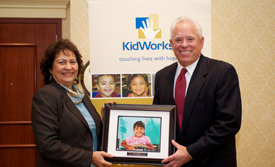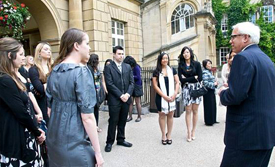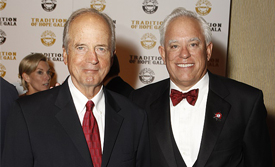Career Education Review Features David Pyle
In Search of Excellence
With David A. Pyle
Founder and CEO, American Career College
Executive Chairman of the Board, West Coast University
How did you get into this business?
I was in the school of business at the University of Southern California. My father, Denver Pyle, had been invited into an investment group. So I saw it as a business plan to start a specialty vocational health care school, exclusively teaching optical dispensing. The company was going to be called American College of Optics. It was March 1977 that I saw the business plan and we were incorporated and launched in January 1978, and had our first start about 90 days after that. I served on the board of directors as the corporate secretary.
So I was in the undergrad school of business, I served as the corporate secretary, and I did a couple of odd jobs operationally. I helped get our first Veteran’s Administration approval, and I helped get our first approval with the Immigration and Naturalization Service. I started that way, learning really at the board level, seeing how the school operated.
In the late 1970s we over-expanded and opened up a second campus in Anaheim. We really didn’t have the management depth or the capital necessary. We were unaccredited at the time. I think one of the lessons that I learned early on, and it’s something that we’ve kept up every day since, is that most importantly we must focus on our student experience and their career opportunities. We didn’t have the placements that we needed. At that time I was not an owner but I was on the board of directors, and the school basically slid into bankruptcy, though we didn’t have enough assets to declare bankruptcy. So I took it over on January 7, 1981. I assumed all the liabilities. The document that I signed looked like the Orange County Yellow Pages. I was just newly out of the University of Southern California. It was one of those times in your early 20s where you have absolutely nothing to lose. I had been very, very vocal about the direction I thought the organization needed to move in, so when I got the chance, I jumped at it.
When you start from a place of less than zero, a half million dollars down, you learn very quickly about what’s important; about how important it is to build strong business relationships and that every moment that you have a student counts. Every time the phone rings, it’s as if it may be the last time somebody calls your organization. You’re living moment to moment when you’re trying to get things turned around. Those same values have permeated our organization every day since.
One of our key things is, you don’t get a second chance to make a great first impression. So every single time a prospective student or a regulator or a parent walks on to our campus, we do everything we can to ensure that we make a first impression that is second to none—every single time.
Let’s go back to those early days. What made you believe you could do it?
To this day, there’s no energy like being on a campus. No matter what’s happening, if I’m having a bad day all I have to do is go out on the campus. I can hit all six Southern California campuses of ACC & WCU within a day’s drive. I just walk onto the campus and see what’s happening and feel that energy—the energy of students, the energy of faculty, seeing that interaction in the classroom. When that’s happening, it’s magical. So if I’m having a tough day and I can walk on that campus and I can see the magic that happens—all eyes forward, students paying attention, the uniforms are on, the classroom is working the way it’s supposed to—I take great pride in that. I’ve been doing this for 34 years and I get great energy from it every single day.
I think I’m an entrepreneur at heart. I’m a problem-solver and I never quit. I keep at it and keep trying to learn every single day. I’m in the learning business, so it’s something that I just can’t get enough of.
You’re in one of the most competitive markets in the country, and one of the most expensive markets. As a relatively small independent going up against publicly traded companies, how did you do this?
I believe we have 40 percent referral rates to our school. It’s an unbelievable number. We do that with a student-centric focus. I don’t think anyone lives that focus like American Career College and West Coast University. We offer a student experience that’s second to none. It’s all about the students—period. You stay focused on that and good things happen, even in challenging times.
How do you keep that culture alive? Now that West Coast has become a regionally accredited university, surely there are a few faculty members who want to plant some ivy.
It starts on the first day. We try to inculcate that cultural value of student centricity and we look for it in every single person that we bring into our family. There are many, many faculty out there who thrive in that culture. They want to get the bureaucracy out. They want somebody who’s behind them in the classroom. I’m so proud of our science programs at West Coast University. In the state of California, we achieved approval from the Board of Registered Nursing for the second ADN ever approved for a for-profit school—the two-year bridge program, VN to RN—and the state and the nursing board were very concerned about whether we could run a top-quality sciences program; that is, chemistry, biology, anatomy and physiology. I put it to our leadership and said this is not rocket science. We have to have great faculty. We’ll spend whatever it takes in that lab to make it right, and we’re going to hit the cover off the ball in the sciences and attract top-level faculty.
Dr. Moe, who heads up the science courses at our Anaheim campus—the Manchester campus—comes out of the UC system. He is in heaven teaching here, because he gets a chance to really engage with students in a way that he’s wanted to do his entire professional career. So for those faculty and associates who want to serve students, this is the best place for them to be.
Talk to me about category killers.
Any time we get into a market, we assess the level of service in that market. Who are the competitors? What are they offering, and can we build a better program? Can we be competitive? There have been some great respiratory therapy programs around in the Orange County market in particular. For a number of years we didn’t get into that. Through the regulatory process, some competitors fell away. From 1990 to 1996 or 1997, about 60–65 percent of our competitors in the L.A. market went away. As some of those competitors fell away, we saw the opportunity to design, build and launch new programs.
Then the next logical extension is how to build a campus from the ground up. I’ve nicknamed it a “category killer,” where you come in and you put up a school the likes of which the competitors in that marketplace, or the students in that marketplace, have never seen. We are a health care education institution; our buildings are designed from the ground up for that specific use.
Our students have certainly seen imagery of Ivy League schools, and there are things architecturally about those campuses that resonate. I want to morph those ideas into our educational experience. So a clock tower, a “quad,” benches, the student break areas, an Internet café, a student union— those kinds of educational icons get morphed into the designs of our campuses. So when a prospective student, regulator or anybody pulls into our parking lot, this is a “category killer.”
Studies show that 80–90 percent of our students had something happen to them that drove them in our door that first day, and it probably wasn’t a good experience. They got fired, they got thrown out of their homes, they didn’t get the raise they wanted—whatever. We made a $30 million investment in our Ontario campus, building from the ground up. When a student walks in that campus, they know that place was built for them. It’s an all-encompassing experience. We put a lot of time and energy into that concept.
The risk of those heavy investments is something that nobody factors in. We put $3 million into our dental hygiene clinic to earn the ability to offer a Bachelor of Dental Hygiene degree. Crazy, insane risk. Not one single approval. Nothing. We decided we were going to build a category killer. We were going to build something so that when the Commission on Dental Accreditation comes to visit, they will see a dental hygiene education facility that is beyond their expectations. That’s the mentality that we have when we’re talking about a category killer.
Some of my readers might say you need some budget discipline. That you could make a whole lot more with a lot less expenditure.
When we launched our Ontario West Coast University campus, we wanted that great first impression. So in the glass foyer/lobby, we cut a hole in the second story and built an Internet café around it. Students hang out there and there’s a break room adjacent. A regional president from one of our competitors, a large publicly traded institution, came by to pay a visit. The first words out of his mouth were, my boss would never let me build anything this inefficient.
Do you think Steve Jobs worried about that at Apple? Do you think everything was about ROI for him? That he wasn’t into the aesthetic? I want to tell you, he’s been a big, big inspiration to me. Bigger, better, cramming more information into this device or that device and also how something looks and feels, whether it’s a technological device, or it’s an educational system. How does West Coast University look and feel? How does American Career College look and feel to a prospective student? Clearly, how the campus gets set up is part of that.
Why two brands? They are both essentially medical curriculums.
Two separate markets.
But they’re across the street from each other.
They are across the street from each other. That is the concept of a career ladder. In everything we do, we take a long-term view. At American Career College, it starts off with an entry-level program—say medical assisting. You go through the program, go to work, generate some income, and come back to vocational nursing at American Career College. Increase your wages, go to work, and then go on to West Coast University for bachelor’s RN, the next step of the rung. Then a Master’s RN—next step of the rung—and eventually a Ph.D. We have taken a career path and broken it into chunks that are affordable and driven by the students’ needs and ability to pay and the time commitment that they have—a truly student-centric focus. When you have 40 percent referral rates and happy students, you can do that. You can take a long-term view of the student success.
But why two brands, two buildings? It would be more efficient with one brand, one big building.
It could be more efficient, but West Coast University is truly that—a university. It is structured. It has the academic rigor of a university. It has all of the systems that I’m so proud of under Dr. Barry Ryan’s leadership that West Coast earned WASC regional accreditation. It has a different set of requirements. That student, just like students in the university system in California, has had more academic success in his life, has graduated high school with good grades, has family support. That market is very different from the American Career College market. My heart will in many ways always be with ACC students. We add so much value there. They have so many things to overcome.
If you look at L.A., our students there are 80 percent women, and many are single mothers. Their opportunity to get into the traditional education system is quite daunting, if not impossible. Always in my mind’s eye, since I acquired West Coast University, was for West Coast to be a graduate school for American Career College. But I always knew it was a university. From the earliest days we had to put in a university level of rigor. It’s a very, very tough program.
Now my challenge to Tom McNamara, president of ACC, is don’t let them get away. Don’t let West Coast get away. What are the programs that we can put in at American Career College to launch and connect a career ladder from ACC to West Coast University? So it’s two brands because they are two separate and distinct markets. I didn’t realize some of the true barriers until we actually got into both. Some regulatory, but mostly socio-economic, barriers that make it so difficult for the American Career College students to achieve success in traditional education.
What is your role in the organization now? You’ve got perfectly wonderful presidents of the two companies. How do you stay out of their way?
I know my limitations as well as what I’m pretty good at. I like to say that the more that I let go the more we grow, when the right people are in the right place. Just when I’m feeling good about something, and I’ve learned a new skill— because I’m trying to learn something new every single day—I think, wow, I feel good about this…that’s when I know that it’s probably time for me to let go and let somebody else step in who actually has a broader experience. This is the only place I’ve worked for 34 years. I don’t know anything else other than this.
It’s very important that I get behind our West Coast University CEO, Barry Ryan, and our American Career College president, Tom McNamara, and that I do everything I can to support those guys. I like to work on a collaborative basis with our leaders. For example, one of the first things that Dr. Ryan did when he came to West Coast was to set up our Oxford study abroad program. Now he wants to do outreach to a Third World country to set up a clinical relationship. I’m getting behind that just as well.
When Tom McNamara came on board—again, in line with student centricity and thinking about a student career ladder and truly being an educator for life—we made an acquisition of a nurse training company called Contemporary Forums. They specialize in continuing education units. We’re going to extend the brand again into serving our vocational nurses at American Career College and our RNs at West Coast University with the nursing product that they have. We want to extend that into dental hygiene. Tom understands about expansion. This was in the first 90 days that he was on board. He made that acquisition happen and we’re in the process of integrating it, and it’s a very exciting opportunity.
Another of my roles is philanthropy. Giving back to those hospitals that have given to our students through the years is mission critical for both West Coast University and American Career College. In particular at West Coast University, we want to be a good WASC citizen. We’re going to do everything we can to make the WASC family proud of West Coast University. One of the ways I believe that we can do that is through philanthropy and giving back.
What’s your future vision? Where do you see your organizations five years from now?
I hope that both American Career College and West Coast University have built a legacy in the healthcare education space that is second to none, that we have grown both domestically and internationally and that we have a reputation for the finest, best-in-class degree programs at West Coast University, and diploma and degree programs at American Career College.
I also hope that we will have built a strong relationship between both ACC and West Coast with the communities that we serve. I hope through that connection some of the misconceptions and stigma that exists today about for-profit colleges will be eroded and we won’t be seen in that negative light. We’ll be seen as something different and we will have accomplished that for the students that we took care of and the patients that they took care of, and the philanthropy that we’ve supported and by being a good education citizen wherever we operate.
That’s what I want to spend the rest of my life doing. I’m very passionate about it. Growing one campus at a time, one program at a time, one student at a time. It really just starts with that one student. We’ve had organic growth here, and that’s one of the things I’m most proud of. I love building a program from the ground up and launching it into a market. I want to be able to continue to do that. Just growing it one student at a time.
Edited by Judi Ditzler and Celia D. Ffrench.




